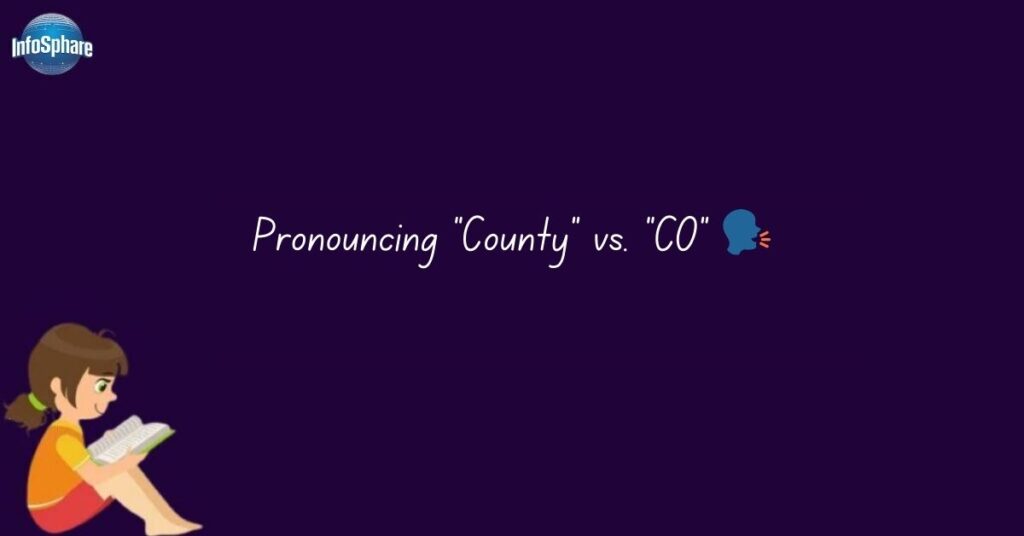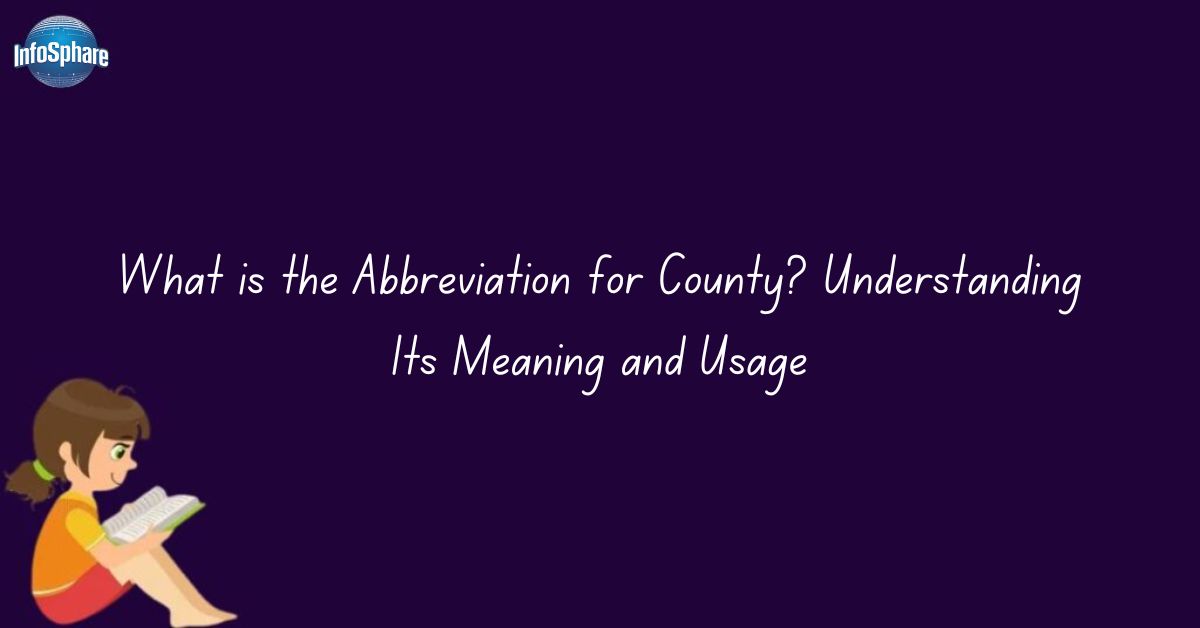Ever wondered how to shorten the word “County” correctly? Many people get confused between “CO”, “Co.”, and other variations, leading to mistakes in addresses, legal documents, and official forms. Understanding the right abbreviation saves time and ensures accuracy in communication.
The correct abbreviation for County is “CO”, widely used in mailing addresses, government records, and administrative forms. It simplifies lengthy text while maintaining clarity and professionalism. But is “Co.” also correct, or does it mean something different?
In this article, we’ll break down the meaning of “CO”, its historical roots, and where to use it correctly. Whether you’re filling out legal paperwork or just curious, knowing the proper county abbreviation is essential. Let’s dive in and clear up any confusion!
Breaking Down the Abbreviation “CO” 📖
The abbreviation “CO” stands for County. It’s a shorthand way to refer to a geographical area within a state or country. Instead of writing out the full word County, CO is used to make things quicker and more efficient in various documents, especially official ones.
What Does “CO” Stand For?
Simply put, “CO” is the shortened version of County. It’s commonly used in mailing addresses, official paperwork, and legal documents. By using CO, people save time and space while still referring to specific regions or areas that are part of a larger area.
Why Is “CO” the Standard Abbreviation?
“CO” became the standard abbreviation for County because it’s short, simple, and widely understood. It helps avoid confusion in postal addresses or other official settings where space is limited. The use of “CO” makes the writing process quicker while still maintaining clarity.
The History and Evolution of the Term ⏳

The term “County” has its roots in early European history, specifically from the Old French word “comté,” which referred to a region ruled by a Count. Over time, as societies evolved, the meaning expanded to represent administrative regions in many countries. The abbreviation “CO” was adopted to simplify the term, especially in written communication and official documents.
The Origins of “County” and Its Abbreviation
The word “County” dates back to the Middle Ages, originating from the idea of a territorial unit governed by a nobleman. The abbreviation “CO” emerged later to provide a quick, efficient way to reference counties in legal documents, mailing addresses, and government papers. It allowed for simplicity while maintaining clear communication.
How the Usage Has Changed Over Time
Originally, the term County referred to large geographical areas, but over time, it became a more standardized term for smaller regions within countries and states. The use of “CO” as an abbreviation gained popularity due to the increasing need for space-saving writing in official forms and postal systems, making it the commonly accepted shorthand in modern times.
Where and How Is “CO” Used? 📍
The abbreviation “CO” for County is widely used in various contexts, particularly when space is limited or efficiency is required. Its primary uses include mailing addresses, filling out forms, and in legal documents, where precise and quick identification of a location is essential. Let’s break down where and how “CO” is applied.
Mailing Addresses 📬
In mailing addresses, “CO” is commonly used to indicate a county when listing an address. For instance, you may see an address like “123 Main Street, CO Los Angeles, CA 90001.” This abbreviation helps streamline the addressing process, especially in regions with multiple counties. Different countries, including the US, the UK, and Canada, adopt the “CO” abbreviation for consistency in postal systems.
Filling Out Forms 📝
When filling out forms, the abbreviation “CO” is often used to indicate the county in various fields, such as personal information, residence details, or jurisdiction. It saves time and space on forms, making the process quicker. However, some forms may ask for full names, so knowing when to use “CO” instead of writing the full word is essential. Always double-check instructions to avoid common mistakes.
Legal and Official Documents ⚖️
In legal and official documents, “CO” is often seen when referencing a county. Whether in government paperwork or business contracts, the abbreviation provides a clear and concise way to refer to a jurisdiction. In legal contexts, abbreviations like “CO” play a critical role in reducing redundancy and ensuring that documents are easy to read and understand.
Also Read this: CNC Meaning: Internet Urban Slang
Pronouncing “County” vs. “CO” 🗣️

Understanding how to pronounce “County” and its abbreviation “CO” correctly is important for clear communication. The full word “County” is typically pronounced as /ˈkaʊnti/, with a long “ou” sound like in “cow” and a soft “y” at the end.
On the other hand, “CO” is pronounced as /koʊ/, just like the first part of the word “company.” While both refer to the same concept, their pronunciations vary based on their usage in different contexts.
How to Say It Correctly
When you’re talking about “County”, remember to enunciate the full word clearly, especially in formal conversations. If you’re using the abbreviation “CO”, you can simply pronounce it as a single syllable, just like saying “co” in “company” or “cooperate.” However, the pronunciation of “CO” might sound slightly different in various accents, but the basic sound remains the same.
Differences in Spoken and Written Use
The major difference between “County” and “CO” lies in spoken versus written use. When you’re speaking, it’s often faster and easier to use “CO” instead of saying “County” each time. However, in writing, especially in formal documents like legal papers or addresses, you’ll more commonly see the full term “County” written out for clarity, while “CO” is used as a shorthand when appropriate. It’s important to match the right form depending on the situation.
Alternative Abbreviations and Acronyms 🔄
While “CO” is the most common abbreviation for “County”, there are a few other ways the term is shortened in various contexts. Some people use “Cnty” or “Cty” as alternative abbreviations, though these are less widely accepted or standardized.
It’s important to note that the abbreviation you choose may depend on the formality of the document or the region in which it’s used, so it’s always best to check the guidelines for your specific use case.
Are There Other Ways to Shorten “County”?
In addition to “CO”, you might encounter “Cnty” or “Cty” in informal documents, such as personal notes or less official forms. However, these alternatives are rarely used in professional, legal, or governmental contexts. For example, “CO” remains the most recognized and widely used abbreviation, especially in addresses, official documents, and legal forms. Knowing the standard abbreviation is key to ensuring clarity in your communications.
The Difference Between “CO” and “Co.”
It’s also important to distinguish between “CO” (the abbreviation for County) and “Co.” (short for Company). While both abbreviations may seem similar, their meanings are entirely different. “CO” refers to a County, a geographical or administrative division, whereas “Co.” refers to a Company, a business entity. The context in which these abbreviations are used will help you determine their correct meaning.
Real-Life Examples of the Word “County” in Context 🌍
The word “County” is frequently used in everyday language, especially when referring to a specific geographical area. For example, someone might say, “I live in Orange County, which is known for its beaches.”
In this context, “County” helps identify the region or administrative area where a person resides. People often use County when discussing local government, community events, or regional distinctions, making it a key term in daily conversations.
Common Uses in Everyday Language
In daily life, the word “County” can be heard in various contexts. Whether it’s someone talking about county fairs, county elections, or county roads, the term helps pinpoint a specific area or jurisdiction.
For instance, you might hear, “The county sheriff is responsible for law enforcement in this area.” In these instances, County is shorthand for a local governing body or administrative region, and it’s often used to give people an idea of the location they are referring to.
How Different Professions Use the Term
The term “County” is often used in specialized professions, such as law, real estate, and government. For example, in law enforcement, professionals may refer to the County Clerk for official records, while in real estate, agents might say, “This property is located in Los Angeles County.”
It’s essential in these fields because it signifies legal jurisdiction, property boundaries, or even tax responsibilities. In government, the term County is used to define political divisions within a state, which play an important role in local administration and services.
When Should You Use the Abbreviation “CO”? ✅
The abbreviation “CO” for County is most often used in formal settings or in documents that require brevity. For example, when writing a formal letter or filling out a government form, you might use “CO” to save space or meet specific formatting guidelines.
In these situations, it’s helpful to understand when it’s appropriate to use the abbreviation, as it ensures clarity and keeps the document professional.
Formal vs. Informal Situations
In formal situations, such as legal documents, mailing addresses, or official records, the abbreviation “CO” is often preferred to ensure consistency and standardization. However, in informal settings, like casual conversation or personal notes, people are more likely to use the full word “County” for clarity.
Using the abbreviation “CO” in an informal context could seem out of place or too technical, so it’s important to consider the tone and audience before using it.
Understanding the Proper Context
Understanding the proper context for using “CO” helps avoid confusion and ensures that it’s used appropriately. In official documents, forms, or business correspondence, the abbreviation is a practical way to streamline communication.
However, in everyday conversation, you might want to stick with the full term “County” unless you’re certain the audience is familiar with the abbreviation. Using “CO” correctly depends on the situation, and being mindful of when and where to use it ensures your communication stays clear and professional.
Other Words Related to “County” 🏙️
When discussing “County,” there are several synonyms and similar terms that may come up, depending on the region or context. For example, “District,” “Region,” or “Borough” are often used in place of “County” in various countries.
These terms may represent similar administrative divisions but can vary in size and function. In some places, a “Parish” or “Shire” might serve a similar role, though they can have their own unique characteristics and historical significance.
Synonyms and Similar Terms
Some of the common synonyms for “County” include “District,” which can refer to a geographical area, or “Province,” which is a larger division within a country. In the UK, the term “Shire” is historically used, referring to a “County” with roots in medieval England.
Other words like “Region” or “Borough” also share similarities in meaning, though they often have a more specific function or government structure tied to them. Understanding these terms can help clarify the meaning when you come across them in different contexts.
Antonyms and Opposites
While “County” refers to a specific area of land or jurisdiction, there are antonyms or opposites to this concept, such as “City” or “Metropolis.” These terms refer to highly urbanized areas that may function differently than a rural “County.”
Additionally, “Country” is another opposite that refers to a much larger political entity, often made up of several “Counties.” By recognizing these distinctions, you can better understand the role and purpose of a County in the broader context of geography and governance.
The Impact of Abbreviations in Language 🏛️
Abbreviations, like “CO” for “County,” play a crucial role in making communication quicker and more efficient. These shortened forms are widely used in both written and spoken language to save time, space, and effort, especially when dealing with long or frequently used terms.
They simplify the way we convey complex ideas without losing meaning, which is especially important in environments that demand fast-paced communication, such as legal documents or official records.
Why Shortened Forms Matter
Shortened forms, such as “CO,” matter because they streamline communication, making it more accessible and efficient. In busy settings like business, government, or even daily interactions, using abbreviations helps people convey key points without unnecessary elaboration.
Abbreviations allow individuals to focus on what truly matters, saving time and reducing the chance for confusion or error when managing large amounts of data, such as addresses or legal documentation.
The Role of Abbreviations in Communication
Abbreviations are essential for effective communication because they help people deliver information quickly without overwhelming their audience. Whether in casual conversation, business letters, or official forms, using abbreviations ensures clarity and consistency.
Furthermore, as language evolves, new abbreviations emerge to meet the changing needs of modern society. The continued use of abbreviations like “CO” demonstrates their ongoing importance in ensuring smooth and efficient interaction across various domains.
Conclusion: The Importance of Understanding “CO” 🌟
Understanding the abbreviation “CO” for “County” is essential for navigating both official and informal communication. By recognizing how this abbreviation is used in various contexts—such as mailing addresses, forms, and legal documents—you can ensure accuracy and avoid confusion.
Knowing when and where to use “CO” not only streamlines communication but also enhances professionalism.
Key Takeaways on the Abbreviation for County
- “CO” is the widely accepted abbreviation for “County.”
- It is used in official documentation, mailing addresses, and legal contexts to simplify lengthy terms.
- Proper use of abbreviations like “CO” ensures clarity, especially in important or formal communication.
Why Correct Usage Matters
Correctly using “CO” shows attention to detail and helps prevent misunderstandings. In settings where precision is critical, such as business correspondence and legal documents, improper abbreviation use can lead to errors. Mastering this abbreviation helps maintain clear and effective communication, whether in personal or professional contexts.
FAQs: Common Questions About “CO” ❓
How do you abbreviate county?
The abbreviation for county is “CO”, commonly used in official documents and addresses. It helps shorten longer terms for convenience.
Is the abbreviation for county co or cty?
The correct abbreviation for county is “CO”, not “CTY”. “CO” is widely accepted in mailing addresses and legal contexts.
Does CO stand for county?
Yes, “CO” is the standard abbreviation for county, especially in official correspondence and documentation. It is widely recognized in both the U.S. and other English-speaking countries.
What is the short cut of county?
The shortened form of county is “CO”. It’s commonly used in forms, addresses, and legal documents for simplicity.
How to Abbreviate county?
The most common abbreviation for “county” is “CO.” This shorthand is widely used in addresses, legal documents, and official communications.
Must Read these magical slangs:
- What is the HYB Meaning in Text and Why It’s So Popular?
- NMMS Meaning in Text: Quick Guide with Examples

Welcome! I’m glad you’re here. My name is Thomas, and this blog is dedicated to English Grammar and more.
I started this blog to share my Grammar site, and it has evolved into a resource where I provide easy and practical tips to help you for better Grammar.



